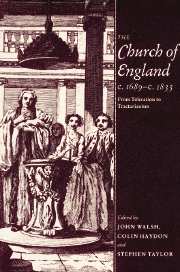Book contents
- Frontmatter
- Contents
- Preface
- List of Abbreviations
- 1 Introduction: The Church and Anglicanism in the ‘long’ eighteenth century
- Part I The pastoral work of the Church
- Part II Crisis and reform
- 5 The Church, the societies and the moral revolution of 1688
- 6 John Locke, Jonas Proast and religious toleration 1688–1692
- 7 The origins and ideals of the SPCK 1699–1716
- 8 Cultural patronage and the Anglican crisis: Bristol c. 1689–1775
- 9 Latitudinarianism at the parting of the ways: a suggestion
- 10 Ecclesiastical policy under Lord North
- 11 The foundation of the Church Missionary Society: the Anglican missionary impulse
- 12 A Hanoverian legacy? Diocesan reform in the Church of England c. 1800–1833
- Part III Identities and perceptions
- Index
11 - The foundation of the Church Missionary Society: the Anglican missionary impulse
Published online by Cambridge University Press: 13 October 2009
- Frontmatter
- Contents
- Preface
- List of Abbreviations
- 1 Introduction: The Church and Anglicanism in the ‘long’ eighteenth century
- Part I The pastoral work of the Church
- Part II Crisis and reform
- 5 The Church, the societies and the moral revolution of 1688
- 6 John Locke, Jonas Proast and religious toleration 1688–1692
- 7 The origins and ideals of the SPCK 1699–1716
- 8 Cultural patronage and the Anglican crisis: Bristol c. 1689–1775
- 9 Latitudinarianism at the parting of the ways: a suggestion
- 10 Ecclesiastical policy under Lord North
- 11 The foundation of the Church Missionary Society: the Anglican missionary impulse
- 12 A Hanoverian legacy? Diocesan reform in the Church of England c. 1800–1833
- Part III Identities and perceptions
- Index
Summary
In October 1795 the editors of the fledgling interdenominational journal,the Evangelical Magazine, founded by the LMS director John Eyre with the partial aim of promoting missions, informed its readers of the spectacular success of a week of meetings held in September to form the London Missionary Society. The first private British missionary society designed exclusively to convert the heathen had been founded three years previously by the Particular Baptists. The LMS, however, was the first interdenominational society and the first to make such a large-scale bid for public support.The Evangelical Magazine was undoubtedly a biased reporter, but itsaccount is nonetheless striking. ‘It is with infinite satisfaction and joy unspeakable, that we now inform our anxious readers that their wishes are not only gratified, but our own expectations far, very far exceeded’.Crowded morning and evening services had been held throughout the week, at one of which thousands had been turned away. On the final evening, some of the ministers present ‘could not, for a time, proceed for tears of joy’.
By 25 September the Anglican Evangelical banker Henry Thornton wasable to write informally to a future leading organizer of the Church Missionary Society, John Venn, on the rapid fund-raising success of the new society:
I have heard today … that £10,000 is said by Mr Haweis to be already collected for the Missionary Society… what a striking thing it is that a Bishop of London [Beilby Porteus]. […]
- Type
- Chapter
- Information
- The Church of England c.1689–c.1833From Toleration to Tractarianism, pp. 247 - 264Publisher: Cambridge University PressPrint publication year: 1993
- 3
- Cited by



